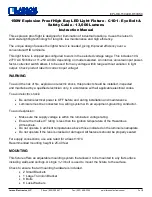
4) Vacuum Interrupter Integrity Test
Use of DC hipot is not recommended, but can
be used for quick field checks only. DC testers
frequently yield false negative test results
due to the capacitive component of the
vacuum interrupter during the DC testing. In
addition, most lightweight DC testers have a
very low leakage current trip setting. Always
recheck with an AC tester if initial results
are questionable. Prior to performing any
vacuum interrupter integrity test, the outside
(external surface) of the vacuum interrupters
should be wiped clean of any contaminates
with a nonlinting cloth or industrial type
wiper. This is critical: the entire external
surface is to be completely free of all dirt,
debris, dust, oil, etc.
NOTICE
X-radiation will be produced if an abnormally
high voltage is applied across a pair of
electrodes in a vacuum. X-radiation will
increase as voltage increases and/or as
contact separation decreases. Only test a
correctly adjusted ground and test device.
During a high potential or vacuum integrity
test, any X-radiation which may be produced
will not be hazardous at a distance safe for
high potential testing, if the tes is conducted
at the recommended voltage and with the
normal open ground and test device gap.
Do not apply voltage that is higher than the
recommended value. Do not use contact
separation that is less than the recommended
open position ground and test device contact
gap.
!
CAUTION
A vacuum integrity test of the interrupter is
required to ensure that no loss of vacuum
has occurred. The vacuum integrity test is
performed using an AC hi-potential tester.
This test of the vacuum interrupter will
determine its internal dielectric condition
and vacuum integrity. With the ground
and test device open, individually check
each interrupter by connecting the hi-pot
machine “Hot” lead to the primary bus bar
and the ground lead to the ground bar on
the mechanism. If the machine has a center
point ground, the connections can be made
either way. Apply minimum of 25kV (rms)
60Hz at 500 volts per second and hold for
10 seconds. If no breakdown occurs, the
interrupter is in acceptable condition. After
the high potential voltage is removed,
discharge any electrical charge that may be
present through the internal ground of the
test machine or by a grounded cable to one
of the phase bus bars. If failure of a vacuum
bottle should occur during the integrity
test, the test procedure should be reviewed
and the pole piece cleaned.
Note the voltage level at failure on the first
test, and retest the phase pole piece. If the
pole piece passes test, the vacuum bottle is
acceptable - STOP. If the test fails again at
a higher voltage level than was observed
in the first test, clean the pole piece and
retest. If a failure on the integrity test
occurs a third time, consider the vacuum
bottle to have lost vacuum and replace the
complete pole piece.
Powered by Safety
®
23
Electrical Checks
01.4IB.50100





































